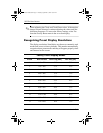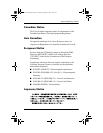
Agency Regulatory Notices
User’s Guide 27
Environmental requirements
Flame retardants
Flame retardants are present in printed circuit boards, cables,
wires, casings and housings. Their purpose is to prevent, or at
least to delay the spread of fire. Up to 30% of the plastic in a
computer casing can consist of flame retardant substances. Most
flame retardants contain bromine or chloride, and those flame
retardants are chemically related to another group of
environmental toxins, PCBs. Both the flame retardants containing
bromine or chloride and the PCBs are suspected of giving rise to
severe health effects, including reproductive damage in
fish-eating birds and mammals, due to the bioaccumulative*
processes. Flame retardants have been found in human blood and
researchers fear that disturbances in foetus development may
occur.
The relevant TCO'99 demand requires that plastic components
weighing more than 25 grams must not contain flame retardants
with organically bound bromine or chlorine. Flame retardants are
allowed in the printed circuit boards since no substitutes are
available.
Cadmium**
Cadmium is present in rechargeable batteries and in the
colour-generating layers of certain computer displays. Cadmium
damages the nervous system and is toxic in high doses. The
relevant TCO'99 requirement states that batteries, the
colour-generating layers of display screens and the electrical or
electronics components must not contain any cadmium.
Sarah User Guide.book Page 27 Tuesday, September 3, 2002 8:33AM


















